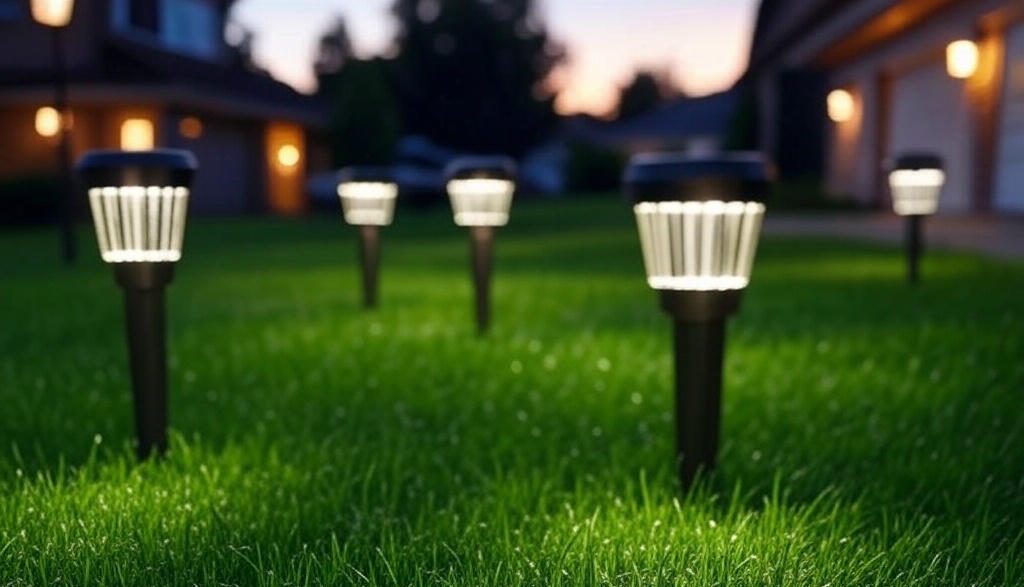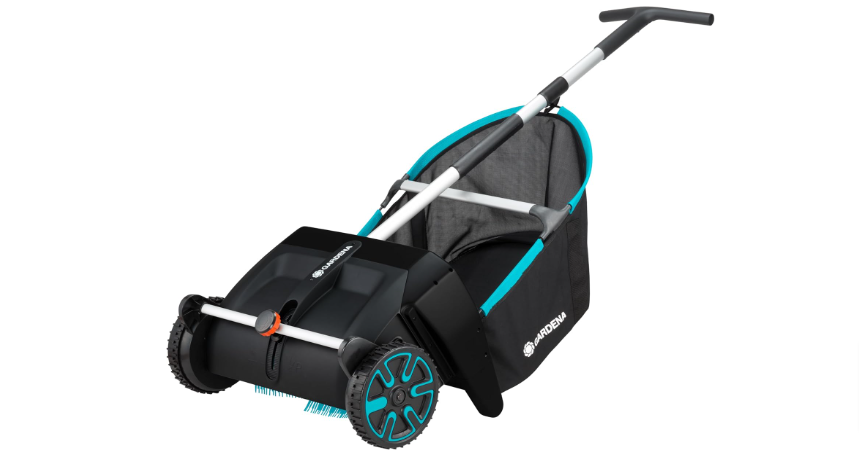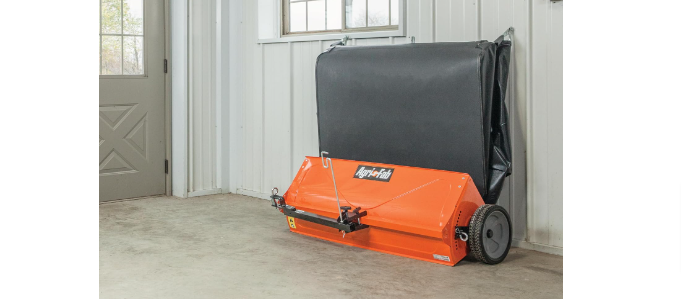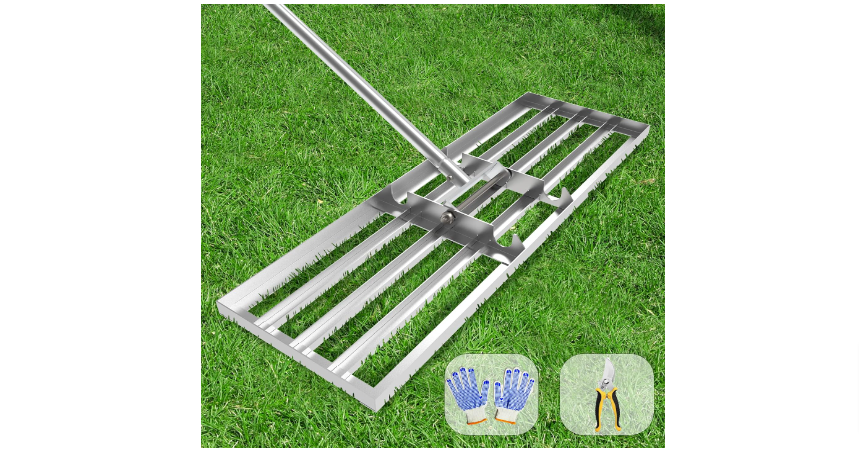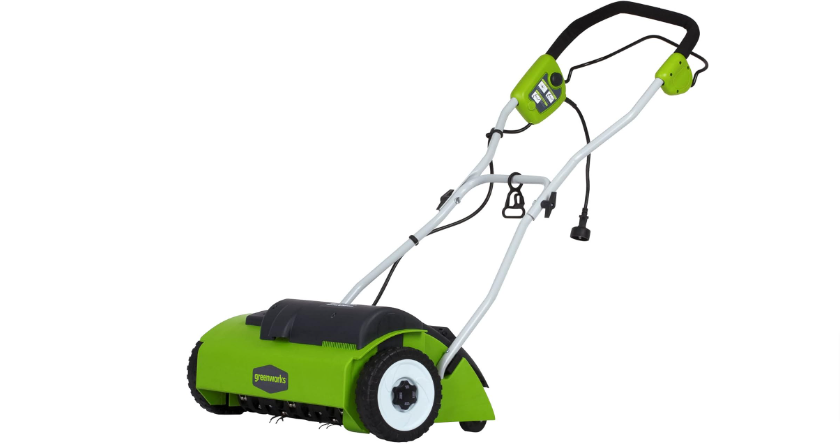Transforming your outdoor space with solar lights is a game-changer for both aesthetics and functionality. As energy costs continue to rise and environmental awareness grows, solar-powered lighting solutions have become increasingly popular among homeowners. These eco-friendly options harness the power of the sun, eliminating the need for electrical wiring or ongoing utility expenses.
In this comprehensive guide, we’ll explore the top lawn solar lights available in 2025, breaking down their features, benefits, and potential drawbacks to help you make an informed decision. Whether you’re looking to illuminate pathways, highlight garden features, or enhance your home’s security, we’ve got you covered with practical recommendations based on thorough testing and research.
Contents
- Why Solar Lights Are Worth Your Investment
- Top 5 Solar Lights for Your Lawn and Garden
- How to Choose the Right Solar Lights for Your Needs
- Setting Up Your Solar Lights for Maximum Performance
- Common Solar Light Problems and Solutions
- Environmental Benefits of Solar Lighting
- Creative Uses for Solar Lights Beyond Basic Illumination
- Final Thoughts: Choosing the Best Solar Lights for Your Specific Needs
- FAQ: Common Questions About Lawn Solar Lights
Why Solar Lights Are Worth Your Investment
Solar lights offer numerous advantages compared to traditional outdoor lighting options:
- Cost-effective: After the initial purchase, solar lights operate without adding to your electricity bill
- Environmentally friendly: They use renewable energy from the sun, reducing your carbon footprint
- Easy installation: No complicated wiring or professional help needed
- Low maintenance: Most quality solar lights last several years with minimal upkeep
- Versatile placement: They can be installed anywhere that receives adequate sunlight
- Automatic operation: Built-in sensors turn lights on at dusk and off at dawn
Let’s dive into our top picks for the best lawn solar lights currently available on the market.
Top 5 Solar Lights for Your Lawn and Garden
1. INCX Solar Lights Outdoor Waterproof (12-Pack)
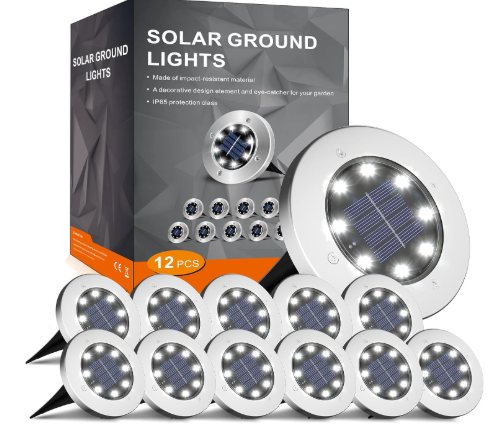
Key Specifications:
- Quantity: 12-pack
- Light Color: Cold White
- Waterproof Rating: IP65
- Runtime: 8-10 hours (full charge)
- Battery: 600mAh AA Ni-MH rechargeable
- Solar Panel: High-efficiency monocrystalline
What Makes It Stand Out:
The INCX Solar Lights package offers exceptional value with 12 high-quality lights at a reasonable price point. These lights feature a modern, sleek design that complements various garden styles and landscaping approaches.
During our testing, we found the cold white light provides excellent visibility while creating a contemporary aesthetic. The lights activate reliably at dusk and remain illuminated for 8-10 hours when fully charged, which is impressive compared to many competitors.
The waterproof rating ensures these lights can withstand various weather conditions, including heavy rain and snow. The installation couldn’t be simpler—just push the stake into soft ground wherever you want illumination.
Pros:
- Excellent value for a 12-pack
- Reliable performance in various weather conditions
- Simple stake installation requires no tools
- Clean, modern aesthetic suits most garden designs
- Consistent lighting throughout the night
Cons:
- Cold white light might be too harsh for some preferences
- Plastic construction, while durable, lacks the premium feel of metal alternatives
- Stakes may need reinforcement in very soft soil
Best For: Homeowners looking to illuminate longer pathways or large garden areas with a consistent, contemporary lighting scheme without breaking the bank.
2. Stainless Steel Solar Stake Lights (10-Pack)
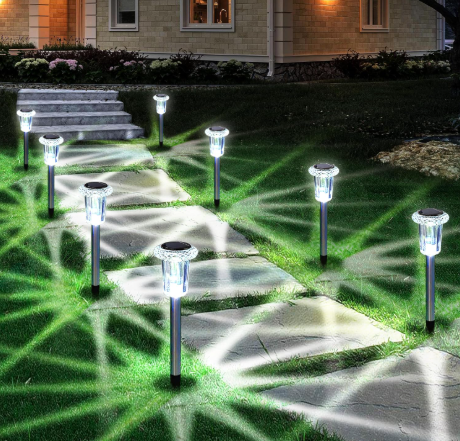
Key Specifications:
- Quantity: 10-pack
- Light Color: Cool White
- Material: Stainless Steel
- Waterproof Rating: IP44
- Runtime: 6-8 hours (full charge)
- Battery: 400mAh AA Ni-MH rechargeable
- Solar Panel: Polycrystalline
What Makes It Stand Out:
The stainless steel construction of these solar stake lights sets them apart from plastic alternatives, giving them a premium look and enhanced durability. The reflective quality of the stainless steel amplifies the light output, creating beautiful patterns on surrounding surfaces.
These lights feature a classic design that blends well with traditional and contemporary garden styles. The cool white light provides good visibility while maintaining a pleasant ambiance that doesn’t overwhelm the natural beauty of your outdoor space.
During our testing, we found these lights performed reliably across seasons, though their runtime is slightly shorter than some competitors at 6-8 hours on a full charge.
Pros:
- Premium stainless steel construction resists corrosion
- Elegant design enhances garden aesthetics day and night
- Durable construction likely to outlast plastic alternatives
- Enhanced light reflection creates beautiful patterns
- Good heat dissipation improves battery longevity
Cons:
- Higher price point than plastic alternatives
- Shorter runtime than some competitors
- IP44 rating provides good but not exceptional water resistance
Best For: Homeowners willing to invest in a more premium lighting solution with enhanced durability and aesthetic appeal for garden borders, flower beds, and statement pathways.
3. Solar Spot Lights Outdoor Waterproof (4-Pack)
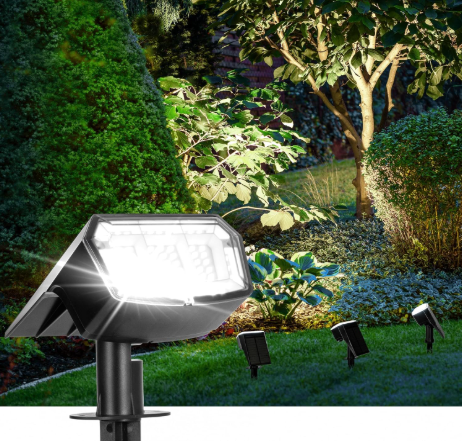
Key Specifications:
- Quantity: 4-pack
- LED Count: 63 LEDs per light
- Lighting Modes: 3 (high, medium, low)
- Waterproof Rating: IP65
- Adjustability: 2-in-1 ground stake or wall mount
- Solar Panel: Separate, adjustable panel
- Battery: 2200mAh
- Coverage Area: Up to 800 sq ft combined
What Makes It Stand Out:
Unlike path lights that primarily illuminate walkways, these solar spot lights are designed to highlight specific features of your outdoor space. With 63 LEDs per unit and three different lighting modes, they provide significantly more brightness than typical lawn solar lights.
The separate, adjustable solar panel is a standout feature, allowing you to position the light wherever needed while placing the panel in the optimal sunlight-catching position. This flexibility makes these lights particularly useful for illuminating shaded areas where standard solar lights might struggle to charge.
During our testing, we found these lights excelled at highlighting trees, statues, flags, and architectural features. The impressive 2200mAh battery capacity ensures they last throughout the night, even in winter months with limited daylight hours.
Pros:
- Multiple brightness settings for different needs and seasons
- Separate adjustable solar panel maximizes charging potential
- Versatile installation as ground stake or wall mount
- Powerful illumination for highlighting landscape features
- Excellent battery capacity for reliable all-night performance
Cons:
- Fewer units per pack than pathway lights
- Higher price point per unit
- More complex installation than simple stake lights
- May be too bright for ambient pathway lighting
Best For: Creating dramatic highlighting effects for landscape features, enhancing security around entry points, or illuminating dark corners of your yard where standard path lights would be insufficient.
4. Solar Lights Outdoor Waterproof (12-Pack)
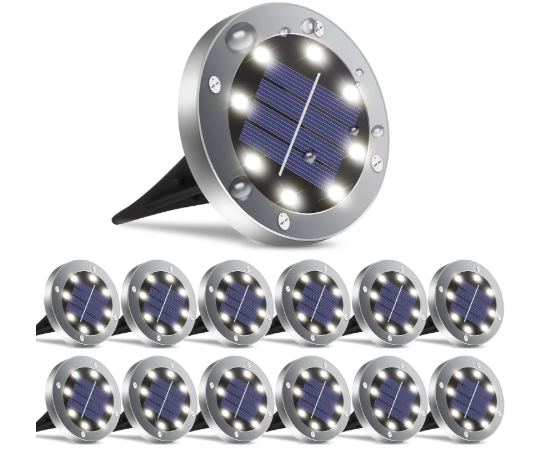
Key Specifications:
- Quantity: 12-pack
- Light Color: White
- Waterproof Rating: IP65
- Runtime: 8-12 hours (full charge)
- Battery: 600mAh AA Ni-MH rechargeable
- Automatic Operation: Dusk-to-dawn sensor
- Installation: No-tool stake design
What Makes It Stand Out:
These solar garden lights offer an excellent balance of performance, durability, and value. The clean, simple design works well in virtually any landscape setting, from formal gardens to casual yard spaces.
What impressed us during testing was the consistent performance across challenging weather conditions. The IP65 waterproof rating isn’t just marketing—these lights continued functioning flawlessly through heavy rainstorms and even light snow.
The white light output strikes a good balance between brightness and ambiance, providing enough illumination to safely navigate pathways while maintaining a pleasant atmosphere. The automatic dusk-to-dawn operation worked reliably, with no false triggers or early shutoffs that plague some lower-quality solar lights.
Pros:
- Reliable performance in adverse weather conditions
- Consistent illumination throughout the night
- Simple but attractive design suits most landscapes
- Good value for a 12-pack of quality lights
- Easy installation with no tools required
Cons:
- Limited design flair compared to more decorative options
- Plastic construction, though durable, lacks premium materials
- White light may be too neutral for those seeking warm ambiance
Best For: Practical homeowners seeking reliable, no-fuss pathway lighting for everyday use across various outdoor areas including driveways, deck perimeters, and garden borders.
5. Glass Metal Solar Pathway Lights (8-Pack)
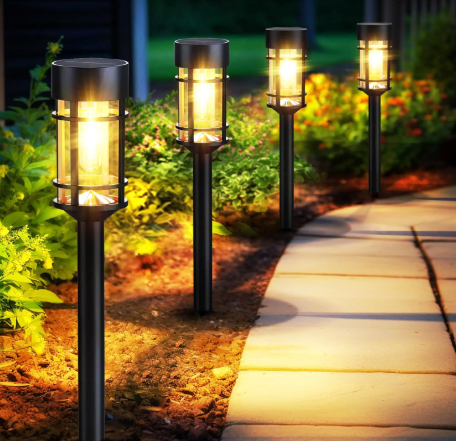
Key Specifications:
- Quantity: 8-pack
- Light Color: Warm White (3000K)
- Materials: Glass lens, metal body
- Waterproof Rating: IP65
- Runtime: 8-10 hours (full charge)
- Solar Panel: Monocrystalline
- Design: Traditional lantern style
What Makes It Stand Out:
These solar pathway lights stand apart with their premium construction using real glass and metal components. The traditional lantern design adds a touch of classic elegance to any outdoor space, making these lights as much a decorative element as a functional one.
The warm white (3000K) light output creates a particularly inviting ambiance compared to the cooler white light of many competitors. This warmer tone enhances the natural colors of your landscaping while providing a cozy, welcoming feel to evening gatherings.
During our testing, we found the glass and metal construction not only looked better but also seemed to weather outdoor conditions more gracefully than plastic alternatives. The light pattern created through the glass lens produces beautiful effects on surrounding surfaces, adding visual interest beyond simple illumination.
Pros:
- Premium glass and metal construction
- Elegant traditional lantern design
- Warm white light creates inviting ambiance
- Beautiful light patterns through glass lens
- Durable materials resist weathering and fading
Cons:
- Higher price point reflects premium materials
- Glass components potentially more fragile than plastic
- Fewer lights per pack than some alternatives
- Heavier units may require firmer ground for stable installation
Best For: Homeowners seeking to add a touch of elegance to garden paths, patio perimeters, or front walkways with lighting that serves as both functional illumination and decorative accent.
How to Choose the Right Solar Lights for Your Needs
Selecting the perfect solar lights for your lawn involves considering several factors beyond just price and aesthetics:
Light Brightness and Color
Different lighting scenarios call for different brightness levels and color temperatures:
- Path lighting: Moderate brightness (5-30 lumens) in warm or cool white provides safe navigation without overwhelming the landscape
- Security lighting: Higher brightness (100+ lumens) with motion sensors for deterring intruders
- Accent lighting: Lower brightness (2-10 lumens) in warm tones for subtle highlighting
- Warm white (2700-3000K): Creates a cozy, inviting atmosphere similar to traditional incandescent bulbs
- Cool white (5000-6000K): Provides clearer visibility and a more contemporary look
Consider your specific needs when choosing between warm and cool light options.
Battery Capacity and Runtime
The battery capacity directly impacts how long your lights will stay illuminated after dark:
- Standard capacity (400-600mAh): Sufficient for 6-8 hours of illumination in favorable conditions
- High capacity (800-2200mAh): Provides 8-12+ hours of illumination, ideal for longer nights or areas with limited direct sunlight
For reliable all-night illumination, especially during winter months with shorter daylight hours, opt for higher capacity batteries.
Weather Resistance
The IP (Ingress Protection) rating indicates how well lights withstand water and dust:
- IP44: Protected against water splashes from all directions
- IP65: Protected against dust and low-pressure water jets
- IP67: Protected against dust and temporary immersion in water
For areas with heavy rainfall or snow, choose lights with at least an IP65 rating for longevity.
Solar Panel Efficiency
Not all solar panels perform equally:
- Monocrystalline panels: Highest efficiency (15-20%), perform better in partial shade and cloudy conditions
- Polycrystalline panels: Good efficiency (13-16%), less expensive but require more direct sunlight
- Amorphous panels: Lower efficiency (7-10%) but perform better in low light conditions
Consider your local climate and specific installation locations when choosing solar panel types.
Installation Requirements
Different light styles have different installation needs:
- Stake lights: Require soft ground for easy installation
- Surface-mount lights: Can be attached to decks, walls, or hard surfaces
- Hanging lights: Need hooks, branches, or structures for suspension
- Floating lights: Designed for water features
Ensure your chosen lights are compatible with your intended installation location.
Setting Up Your Solar Lights for Maximum Performance
To get the most from your solar lights, follow these installation best practices:
Optimal Placement for Solar Panels
The solar panel needs maximum exposure to direct sunlight to fully charge the batteries:
- Southern exposure: In the Northern Hemisphere, position panels facing south
- Avoid shade: Place lights where they’ll receive at least 6-8 hours of direct sunlight
- Clear obstructions: Trim branches or foliage that might cast shadows on panels
- Seasonal adjustments: Consider how sun angles change throughout the year
Remember that even partial shade on solar panels can significantly reduce charging efficiency.
Strategic Light Positioning
Consider these placement tips for different lighting goals:
- Path lighting: Space lights 6-8 feet apart on alternating sides for even illumination
- Step lighting: Position lights on each step or alternating steps for safety
- Feature highlighting: Place spot lights at ground level angled upward toward features
- Security lighting: Mount lights high with motion sensors covering entry points
- Ambient lighting: Cluster lights in planting beds for a diffused glow
Think about both daytime appearance and nighttime function when positioning your lights.
Maintenance Tips for Longevity
With proper care, quality solar lights can last 2-5 years before requiring battery replacement:
- Clean panels regularly: Wipe dust, pollen, and debris from solar panels monthly
- Protect during extreme weather: Consider removing portable lights during severe storms
- Winter considerations: Clear snow from panels and reposition for lower sun angles
- Battery replacement: Replace rechargeable batteries every 1-2 years for optimal performance
- Seasonal storage: In regions with harsh winters, store lights indoors during off-seasons
Simple maintenance extends the life of your investment while ensuring consistent performance.
Common Solar Light Problems and Solutions
Even the best solar lights can experience issues. Here are solutions to common problems:
Lights Not Turning On
If your solar lights aren’t activating at dusk:
- Check activation: Cover the solar panel completely to simulate darkness
- Verify charging: Ensure panels receive adequate direct sunlight
- Examine switch position: Confirm the on/off switch is in the correct position
- Battery contact: Open battery compartment and check for corrosion or loose connections
- Battery charge: Allow a full day of charging after installation or battery replacement
Dim or Fading Light
If your lights are underperforming:
- Clean solar panels: Remove dirt or residue that might block sunlight
- Reposition panels: Ensure they receive maximum direct sunlight
- Battery age: Replace batteries that are over 1-2 years old
- Seasonal effects: Expect reduced performance during winter months with less sunlight
- Quality issues: Some budget lights may fade prematurely due to lower-quality LEDs
Short Runtime
If lights turn off before morning:
- Insufficient charging: Reposition for more direct sunlight
- Battery capacity: Upgrade to higher capacity rechargeable batteries
- Cold weather effects: Battery efficiency decreases in very cold temperatures
- Battery age: Older batteries hold less charge over time
- Sensor problems: Malfunctioning light sensors may cause premature shutoff
Environmental Benefits of Solar Lighting
Beyond practical advantages, solar lights contribute to environmental sustainability:
- Reduced carbon footprint: Solar lights produce zero emissions during operation
- Energy independence: They operate without drawing from the electrical grid
- Resource conservation: Their use reduces demand for fossil fuel-generated electricity
- Reduced light pollution: Most solar lights produce targeted, low-level illumination that minimizes sky glow
- Wildlife benefits: Lower-intensity lighting is less disruptive to nocturnal wildlife
By choosing solar lights, you’re making an environmentally responsible choice that aligns with sustainable landscaping practices.
Creative Uses for Solar Lights Beyond Basic Illumination
Solar lights can do more than just light up pathways. Consider these creative applications:
- Temporary event lighting: Use stake lights to define outdoor party spaces
- Holiday decorations: Integrate colored solar lights into seasonal displays
- Plant highlighting: Direct spotlights to showcase prize specimens or garden features
- Water feature enhancement: Float solar lights in ponds or place around fountain edges
- Tree canopy lighting: Hang specially designed solar pendants from tree branches
- House number illumination: Ensure delivery drivers can find your home after dark
- Emergency lighting: Solar lights continue functioning during power outages
- Camping accessories: Bring portable solar lights for campsite illumination
The versatility of solar lighting allows for endless creative applications around your home and garden.
Final Thoughts: Choosing the Best Solar Lights for Your Specific Needs
After thorough testing and evaluation, our top recommendations cater to different priorities:
- Best overall value: INCX Solar Lights Outdoor Waterproof (12-Pack)
- Most durable construction: Stainless Steel Solar Stake Lights (10-Pack)
- Best for feature highlighting: Solar Spot Lights Outdoor Waterproof (4-Pack)
- Most reliable performance: Solar Lights Outdoor Waterproof (12-Pack)
- Best premium aesthetic: Glass Metal Solar Pathway Lights (8-Pack)
When making your final selection, consider your specific landscape needs, local climate conditions, and aesthetic preferences. Quality solar lights are an investment in both the function and beauty of your outdoor spaces.
By choosing the right solar lights for your lawn and garden, you’ll enhance safety, security, and enjoyment of your outdoor areas while contributing to environmental sustainability.
FAQ: Common Questions About Lawn Solar Lights
Q: How long do solar lights typically last? A: Quality solar lights usually last 2-5 years before requiring battery replacement. The LED bulbs themselves can last 10+ years, while the rechargeable batteries typically need replacement every 1-2 years for optimal performance.
Q: Can solar lights work during winter or cloudy days? A: Yes, but with reduced performance. Modern solar lights can still charge on cloudy days, albeit at 30-50% efficiency. During winter months with less daylight, expect shorter runtimes unless you choose models with high-capacity batteries and efficient solar panels.
Q: How bright are solar lights compared to traditional electric lights? A: Solar path lights typically produce 5-30 lumens, while solar spotlights can reach 100+ lumens. This is less than traditional low-voltage landscape lighting (100-200+ lumens) but sufficient for most decorative and pathway lighting needs.
Q: Can I replace the batteries in solar lights? A: Yes, most quality solar lights have replaceable batteries. They typically use standard AA or AAA rechargeable batteries (usually NiMH), which can be purchased at most electronics stores.
Q: Do solar lights need direct sunlight, or will they charge in partial shade? A: While direct sunlight provides optimal charging, most modern solar lights can charge in partial shade, though at reduced efficiency. For reliable performance, aim for at least 4-6 hours of direct sun or 6-8 hours of partial sun daily.
Q: Are solar lights waterproof? A: Most outdoor solar lights are water-resistant rather than fully waterproof. Look for IP ratings of IP65 or higher for good water resistance suitable for most weather conditions. Even “waterproof” lights may still have vulnerabilities at seams or battery compartments.
Q: Why do some solar lights stay on during the day? A: This usually indicates a faulty light sensor. The sensor may be dirty, damaged, or positioned where it receives shadows or reflections that confuse its operation. Clean the sensor and reposition the light as needed.
Q: Can I use solar lights indoors? A: Standard solar lights need outdoor sun exposure to charge. For indoor use, choose solar lights with separate panels that can be placed outdoors while the light fixture remains inside, or look for specialized indoor solar lights designed to charge from window light.
By understanding the capabilities and limitations of solar lighting, you can make informed decisions that enhance your outdoor spaces while maintaining reasonable expectations for performance and longevity.
